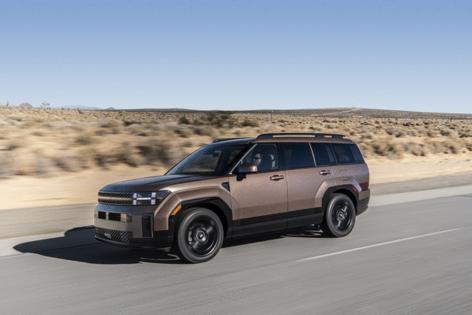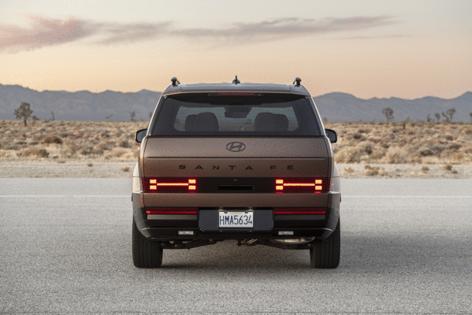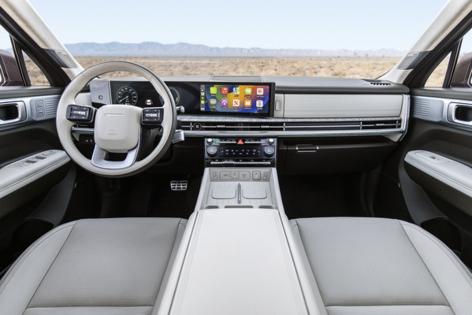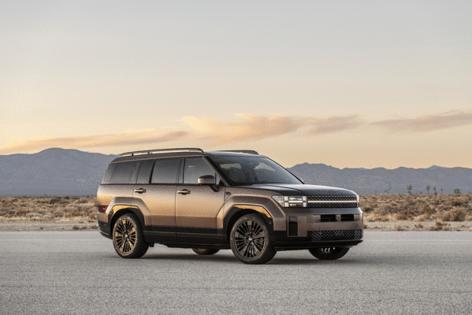Auto review: 2024 Hyundai Santa Fe looks better than it drives
Published in Automotive News
You have to applaud the Hyundai executives and designers for the redesigned 2024 Hyundai Santa Fe, the company’s three-row crossover. In a market where bland design uniformity prevails, it stands apart, a brutalist breadbox that proudly proclaims its identity. There’s no mistaking it for anything else — except possibly as a Land Rover Defender knock-off.
That’s especially true of my test vehicle, finished in Earthy Brass Matte paint, aka topsoil.
Offered in SE, SEL, XRT, Limited and Calligraphy trim, the 2024 Santa Fe is two inches longer than the outgoing model, and designers have accentuated its large flat surfaces with a wide horizontal grille, along with horizontal front and rear lighting that form an H when lit.
Yet inside the 2024 Santa Fe, its square-sided style pays big dividends. There’s as much as 80 cubic feet of cargo space with the seats folded, and 15 cubic feet when they’re all in use. Accessing the cargo area is easy thanks to its massive rear tailgate. It also allows for large, tall windows, lending the driver excellent visibility in all directions. It also endows the cabin with a comfortable seat height and plentiful head and leg room.
More noticeable is its interior ambience. Our top-of-the-line Calligraphy model possessed a mix of light-colored materials with interesting textures, lending the cabin a contemporary premium vibe that recalls Land Rovers. Then there are the thoughtful touches that make living with the Santa Fe day to day so easy. There are tons of USB-C plugs, in addition to two wireless smartphone chargers up front. Second row passengers can easily access the front row, dual-hinged center console bin. An ultraviolet light-based sterilization compartment is available for frequently used items such as cell phones and wallets. Wireless Apple CarPlay and Android Auto are standard.
Much like the rest of the car, the instrument panel has a strong horizontal orientation accentuated by a 12.3 -inch digital instrument cluster and a 12.3-inch infotainment touchscreen. The driver’s display can be adjusted to one of several arrangements, while the touchscreen employs Hyundai’s easy-to-use software with slender, elegant physical shortcut buttons beneath it. Thankfully, climate controls are housed in a separate panel on the lower part of the instrument panel.
The three-row Santa Fe comes measures 190 inches long, making the third row’s legroom rather tight. Best to leave it folded for extra cargo space. Passengers had more than enough room in the first two rows. Road noise was about average for the class.
The Santa Fe is powered by a 2.5-liter direct-injected, turbocharged four-cylinder engine and an eight-speed dual-clutch transmission that generates 277 horsepower and 311 pound-feet or torque. Front-wheel models return an EPA-estimated 24 mpg in combined driving; all-wheel drive, 23 mpg. All Santa Fes use regular unleaded fuel.
Hyundai also offers a hybrid variant, with a 1.6-liter turbocharged four-cylinder gas engine and a six-speed automatic transmission. Rated at 231 horsepower and 271 pound-feet or torque, its front-wheel-drive model returns an EPA-estimated 36 mpg, with all-wheel-drive models clocking in at 34 mpg.
The Santa Fe’s driveline proves to be the biggest disappointment. Power is sufficient, but extracting it means dealing with quite a bit of engine noise. Worse, there is a lot of turbo lag off the line, with what seems like an interminable wait on initial acceleration until anything happens. Then, the driveline kicks in aggressively. It is especially noticeable when the vehicle is in Sport driving mode, with the dual-clutch transmission shifting nervously.
If the fuel economy was good, it would be worthwhile. But a week-long drive of an all-wheel-drive Calligraphy returned 18 mpg in mixed city/highway driving, with roughly half of the driving occurring at highway speed. And this is on a vehicle with 7,500-plus miles on the clock, so the engine is broken in.
Given the bold design treatment, you might expect a driving dynamic as muscular as its looks. However, like all Santa Fes ever built, driving it is wholly unremarkable. Then again, many competitors, including any number of Toyotas, are equally unexceptional. Clearly, its driving experience lags its design excellence.
It is said good artists copy; great artists steal. If the 2024 Hyundai Santa FE stands out, it does so in its looks — not to mention its dirt brown paint. Much like a fast fashion retailer, the Santa Fe belies its price, even if its inspiration is clear.
2024 Hyundai Santa Fe
Base price: $33,950-$48,800
Engine: Turbocharged 2.5-liter four-cylinder
Horsepower/Torque: 277/311 pound-feet
EPA rating (combined city/highway): 23 mpg
Fuel required: Regular
Length/Width/Height: 190/75/70 inches
Ground clearance: 7 inches
Payload: 1,191 pounds
Cargo capacity: 15-80 cubic feet
Towing capacity: 1,650-4,500 pounds
©2024 Tribune Content Agency, LLC















Comments